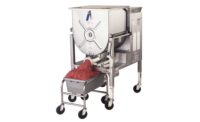|
|
| Participating in the ribbon cutting ceremony at IPPE 2013 were (left to right) Joel Newman, president of AFIA; Al Gunderson, chairman of AFIA; Gary Cooper, immediate past chairman of USPOULTRY; John Starkey, president of USPOULTRY; Mark Waller, chairman of USPOULTRY; Larry Odom, immediate past chairman of AMI; and Patrick Boyle, president and CEO of AMI. |
Few will argue the fact that consolidations have taken their toll in the meat and poultry industries — not only in the processor arena, but mergers among suppliers have accelerated in the last 10 years.
In the fast-changing environment of technology and business regimens, those who do not adapt — and adapt quickly — are destined to meet the same fate as a number of household names, such as Polaroid and Kodak. Just yesterday, I was reminiscing with a techie about the old computer brands that were household names but now gravestones: Word Perfect, Harvard Graphics, Lotus, dBase, VisiCalc … the list goes on.
The same holds true for trade shows. Those that cannot adapt to the new ways of conducting business are destined for failure. Few people will argue that face-to-face marketing is one of the most effective tools in sales and marketing, and to establish an environment that creatively brings customers and suppliers together requires new skill sets.
Suppliers who exhibit at trade shows incur considerable expense, and in the latter part of the last century, the number of shows proliferated. Through the consolidation of target audiences, the pressures on trade shows to adapt have been enormous. The successful ones are those that broaden their scope through strategic alliances.
In 2007, the International Poultry Expo (IPE) joined forces with the American Feed Industry Association’s International Feed Expo (IFE) to help broaden the scope of the two shows while building on complementary interests. In that endeavor, the IFE has experienced a doubling of its exhibitor numbers.
For the 2013 show, IPE/IFE expanded through the integration of American Meat Institute’s long-standing show. The three-show combination was re-branded as the International Production & Processing Expo (IPPE). The new partnership yielded results that exceeded everyone’s expectations.
The 2012 IPE/IFE had 895 exhibitors, 295,000 net square feet of exhibit space, and close to 21,000 attendees. The 2013 IPPE, held in January 2013, featured 1,189 exhibitors, more than 430,000 net square feet of exhibit space, and 26,393 attendees.
How does one explain the boom? Exhibitors recognize that the joining of a traditional red meat show with a poultry show makes sense. Most processing-equipment manufacturers have product lines in several protein sectors, and the partnerships have provided three shows in one — therein providing a more efficient use of exhibit resources.
It also makes sense in that a number of the major processing players in the industry have a presence in both the red meat and poultry sectors: Tyson, Cargill, Smithfield and Prestage Farms, just to name a few. Additionally, the combined shows have drawn heavily on the international community, where many of the companies are not only focused on poultry but have beef and pork operations, especially in Latin America. The 2013 IPPE brought in 5,448 attendees from outside of the U.S., representing 111 countries.
As IPPE positions itself for the future, it will continue to broaden its reach in the protein sector. The 2014 IPPE will feature an exhibit area highlighting swine production to complement the poultry production long associated with the show. The goal is to provide farm-to-table coverage of animal agriculture.
Synergy arises when 1+1=3. Separate entities complement each other, and the combination yields greater results than could be accomplished by each acting separately.
Synergy appears to have been clearly demonstrated by the 2013 IPPE, and will continue through future IPPE shows.





Report Abusive Comment